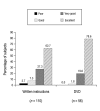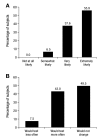Evaluation of an over-the-counter glycated hemoglobin (A1C) test kit
- PMID: 21129346
- PMCID: PMC3005061
- DOI: 10.1177/193229681000400625
Evaluation of an over-the-counter glycated hemoglobin (A1C) test kit
Abstract
Background: Glycated hemoglobin (A1C) monitoring is an integral component of diabetes management. This study was conducted to evaluate the performance of the A1CNow® SELFCHECK device when used by lay users and health care professionals (HCPs) to measure A1C.
Methods: Subjects performed two A1CNow SELFCHECK finger-stick self-tests followed by a finger-stick test of the subject's blood by a HCP. The primary endpoint assessed accuracy of the subject and HCP A1CNow SELFCHECK readings. Secondary endpoints included precision, comprehension of instructional material (written material±DVD), and product satisfaction. For accuracy comparison, a venous blood sample was drawn from each subject and tested by laboratory (TOSOH) analysis. Subject comprehension of product instructional material was evaluated via first-time failure (FTF) rate as recorded by the HCP, and subject satisfaction was assessed through written survey.
Results: A total of 110 subjects with (n=93) and without (n=17) diabetes participated. Of 177 subject A1C values, 165 (93.2%) were within the acceptable range of ±13.5% of the laboratory reference value and considered accurate. Regression analysis showed good correlation of subject values to laboratory and HCP results (R2=0.93 for both). The average within-subject coefficient of variation was 4.57% (n=74). The FTF rates with and without instructional DVD were 11.3% (n=56) and 39.6% (n=54), respectively. Subjects with diabetes/prediabetes overwhelmingly indicated that they were "very" to "extremely" likely (93.5%) to discuss their home A1C results with their HCP.
Conclusions: Lay users found the A1CNow SELFCHECK easy to use, and both lay users and HCPs were able to measure A1C accurately.
© 2010 Diabetes Technology Society.
Figures






Comment in
-
Analysis of point-of-care and over-the-counter testing methods for hemoglobin A1c: how good do they need to be?J Diabetes Sci Technol. 2010 Nov 1;4(6):1504-6. doi: 10.1177/193229681000400626. J Diabetes Sci Technol. 2010. PMID: 21129347 Free PMC article.
Similar articles
-
Analysis of point-of-care and over-the-counter testing methods for hemoglobin A1c: how good do they need to be?J Diabetes Sci Technol. 2010 Nov 1;4(6):1504-6. doi: 10.1177/193229681000400626. J Diabetes Sci Technol. 2010. PMID: 21129347 Free PMC article.
-
Prospective evaluation of accuracy, precision, and reproducibility of an at-home hemoglobin A1c sampling kit.Diabetes Technol Ther. 1999 Winter;1(4):411-9. doi: 10.1089/152091599316928. Diabetes Technol Ther. 1999. PMID: 11474825 Clinical Trial.
-
Assessment of the performance of A1CNow(+) and development of an error grid analysis graph for comparative hemoglobin A1c measurements.Diabetes Technol Ther. 2014 Jun;16(6):363-9. doi: 10.1089/dia.2013.0289. Epub 2014 Apr 25. Diabetes Technol Ther. 2014. PMID: 24766632 Free PMC article.
-
Use of high-normal levels of haemoglobin A(1C) and fasting plasma glucose for diabetes screening and for prediction: a meta-analysis.Diabetes Metab Res Rev. 2013 Nov;29(8):680-92. doi: 10.1002/dmrr.2445. Diabetes Metab Res Rev. 2013. PMID: 23963843 Review.
-
Behavior Modification in Prediabetes and Diabetes: Potential Use of Real-Time Continuous Glucose Monitoring.J Diabetes Sci Technol. 2019 Mar;13(2):271-275. doi: 10.1177/1932296818790994. Epub 2018 Aug 1. J Diabetes Sci Technol. 2019. PMID: 30066574 Free PMC article. Review.
Cited by
-
Peer-Delivered Cognitive Behavioral Training to Improve Functioning in Patients With Diabetes: A Cluster-Randomized Trial.Ann Fam Med. 2020 Jan;18(1):15-23. doi: 10.1370/afm.2469. Ann Fam Med. 2020. PMID: 31937528 Free PMC article. Clinical Trial.
-
Is there a relationship between mean blood glucose and glycated hemoglobin?J Diabetes Sci Technol. 2011 Nov 1;5(6):1572-83. doi: 10.1177/193229681100500634. J Diabetes Sci Technol. 2011. PMID: 22226280 Free PMC article. Review.
-
Trends in Quantification of HbA1c Using Electrochemical and Point-of-Care Analyzers.Sensors (Basel). 2023 Feb 8;23(4):1901. doi: 10.3390/s23041901. Sensors (Basel). 2023. PMID: 36850502 Free PMC article. Review.
-
Participant engagement in a community health worker-delivered intervention and type 2 diabetes clinical outcomes: a quasiexperimental study in MexicanAmericans.BMJ Open. 2022 Nov 29;12(11):e063521. doi: 10.1136/bmjopen-2022-063521. BMJ Open. 2022. PMID: 36446462 Free PMC article.
-
Point-of-Care HbA1c Testing with the A1cNow Test Kit in General Practice Dental Clinics: A Pilot Study Involving Its Accuracy and Practical Issues in Its Use.Point Care. 2014 Dec;13(4):142-147. doi: 10.1097/POC.0000000000000039. Point Care. 2014. PMID: 25593546 Free PMC article.
References
-
- Centers for Disease Control and Prevention . National diabetes fact sheet: general information and national estimates on diabetes in the United States, 2007. Atlanta, GA: U.S. Department of Health and Human Services, Centers for Disease Control and Prevention; 2008.
-
- The Diabetes Control and Complications Trial Research Group The effect of intensive treatment of diabetes on the development and progression of long-term complications in insulin-dependent diabetes mellitus. N Engl J Med. 1993;329(14):977–986. - PubMed
Publication types
MeSH terms
Substances
LinkOut - more resources
Full Text Sources
Medical
Miscellaneous

